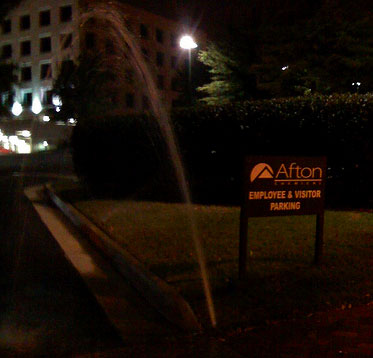The first thing that my neighbors and I noticed on the handout sheet for this meeting was this sentence, “Oregon Hill residents have had a strong voice in VCU development as it has affected the neighborhood.” Was this before or after whole blocks of Oregon Hill were torn down for VCU’s expansion across Main Street? Or was this when VCU insisted on moving the Jacob House despite protest? Or was it more recent, when VCU tore down a historic stable despite repeated objections from the neighborhood association? What a joke! Richmond be warned- VCU does not care what citizens and residents want. They have very little love for a public-driven master plan that they see as meddling with their university master plan. VCU did not say anything at this meeting because it did not need to- it already has its own hooks in the City and State government.
Phfew! Had to get that off my chest.
Despite that editorial, I will say that tonight’s meeting at the William Byrd Community House was a successful one. Barbara Abernathy began the meeting with a quick, thankful call for participation. I counted over 60 people in attendance, with enough diversity to ensure that the meeting was not overly dominated by Oregon Hill residents. Brooke Hardin of the City’s Community Development Dept. served as presenter/moderator. Due to technical difficulties there was no slide show. Over the last 8 months, the City held a number of ‘charrette’ planning sessions, and Hardin quickly listed and described the 7 main points that had emerged from them- including the emphasis on traditional city/historic preservation, the need for ‘green’, access to the James River, and the desire for mixed income residential base. The downtown footprint has increased and this meeting was in part on how surrounding neighborhoods and VCU play into that.
From there, Hardin referred to what has been written in the proposed Downtown Master plan for this area. Some of the written points: plant more street trees and enhance pedestrian environment, increase transit opportunities (including BRT), encourage VCU campus infill, prohibit future street closings, promote Monroe Park, establish a sustainable design center, continue neighborhood preservation efforts in Oregon Hill (the idea of OH getting Old and Historic District designation is pronounced), preserve and connect Oregon Hill’s parks, encourage compatible infill in Monroe Park, and revitalize Grace Street.
After the City’s presentation, questions and comments came from the audience. Jason Roberts, an Oregon Hill resident, expressed support for the idea of re-connecting Pine Street across the 195 expressway, and using the resulting reclaimed area for green, open space. I raised my hand and used Jason’s comment to segue into a plea for recognition of the Belvidere Greenway that could connect the James River Park north to Monroe Park, and then to Carver (something that OH has had in its own master plan for decades). I also reminded City planners about the popular idea of retooling Idlewood west of Cherry as a two way street with a roundabout off the expressway exit ramp. I reiterated a call for boundaries with binding agreements from VCU.
Monroe Ward residents supported the idea of making Grace St. two-way and also asked about Main and Cary. Some expressed concerns that parking VCU students would cause delays on two-way streets. Many citizens liked the idea of more trees and were also interested in more trash cans and streetscape improvements. Paul Holland brought up safety concerns along with support for transit connectors and a refurbished Monroe Park.
Carver neighborhood residents were interested in a couple of aspects. One resident thought Gilmore Street should be considered for two-way traffic. Many were surprised that more of Carver did not appear in the Downtown Master plan study, and wanted to see the whole neighborhood to come under consideration. They felt that streetscape improvements are badly needed there.
The comments kept coming. Perhaps piqued by Carver’s request, some property owners/managers wanted to know more about the plan and if there would be other parts of the City studied in the future (the answer was a tentative yes). Josh Irwin thought that code enforcement should be a bigger part of renewed attention to streetscape issues. Concern was expressed about the high rise/gas station development proposed for where the BP station is currently at the corner of Grace and Belvidere. Hardin explained that his department primarily looks at proposals like that for overall urban compatibility rather than specific architecture. One gentlemen made good points about creating more emphasis on making the VCU area more bicycle and pedestrian friendly with particular attention on crosswalks. Linda, a resident of Carver, said she had seen a lot of transportation planning come and go in Richmond, but the question of who was it for does not come often enough. She said that more traffic enforcement is needed and the counties must take part in transportation planning. Oregon Hill resident Todd Woodson welcomed and thanked Carver residents for visiting Oregon Hill for the meeting. He said that the urban forestry program needs to be brought back to strength. And he finished by saying that it was a shame that the Mayor put an end to the Neighborhood Teams civic program.
With that portion of the meeting over, many attendees took the time to fill out comment slips, look at maps, and ask questions of the many members of City staff who were in attendance. I noticed a few members of the media there, so maybe this meeting will receive some more coverage.

